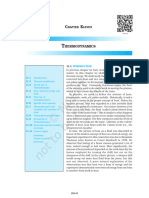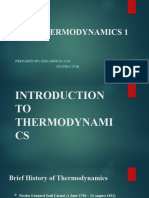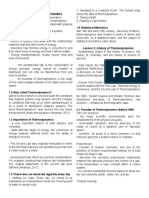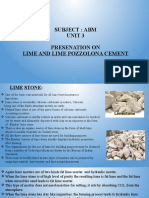Basic-Thermodynamics 1
Basic-Thermodynamics 1
Uploaded by
Kawie AñeroCopyright:
Available Formats
Basic-Thermodynamics 1
Basic-Thermodynamics 1
Uploaded by
Kawie AñeroOriginal Description:
Original Title
Copyright
Available Formats
Share this document
Did you find this document useful?
Is this content inappropriate?
Copyright:
Available Formats
Basic-Thermodynamics 1
Basic-Thermodynamics 1
Uploaded by
Kawie AñeroCopyright:
Available Formats
Homework #1: Deadline is on Sept. 18, 2023 at 3pm. At UCU.
Write a research paper indicating the application of thermodynamics in our society. Cite examples that
are found in a common household. Write it on a long white coupon bond. Minimum of 250 words.
Basic Thermodynamics
Module 1 – Introduction to Thermodynamics
c. Third law of thermodynamics
d. Zeroth law of thermodynamics
TOPIC 3. The specific gravity of a substance is the ratio
OUTLINE of its density to the density of _________.
a. Mercury
1. Development of Thermodynamics b. Gas
2. Law of Thermodynamics c. Air
d. Water
4. Based on the first law of thermodynamics,
LEARNING which of the following is wrong:
OBJECTIVES a. The heat transfer equals the work plus
the energy change
b. The heat transfer cannot exceed the work
After studying this module, you as a future done
Mechanical Engineer should be able to: c. The net heat transfer equals the network
of the cycle
• Define the concept of thermodynamics; d. The net heat transfer equals the energy
• Familiarize the laws and principles of change if no work is done
thermodynamics.
INTRO TO
THERMODYNAMICS
OVERVIEW
Thermodynamics is the branch of the physical
sciences that studies the transfer of heat and the
Module 4 serves as a brief discussion about the inter-conversion of heat and work in various physical
basic concepts of thermodynamics. It gives us an and chemical processes. The study of
overview on the forms of energy and the laws thermodynamics is central to both chemistry and
governing it. This module is good for 2 hour lecture. physics and is becoming increasingly important in
understanding biological and geological processes.
ACTIVATING There are several sub-disciplines within this blend of
PRIOR KNOWLEDGE chemistry and physics. Classical thermodynamics
consider the transfer of energy and work in
1. Form of energy associated with the kinetic macroscopic systems that is, without any
energy of the random motion of large number of consideration of the nature of the forces and
molecules: interactions between microscopic individual
a. Internal energy particles. Statistical thermodynamics links the
b. Kinetic energy atomic nature of matter on a microscopic level with
c. Heat of fusion the observed behavior of materials on the
d. Heat macroscopic level. Statistical thermodynamics
2. Heat normally flowing from a high temperature describes energy relationships based on the
body to a low temperature body wherein it is statistical behavior of large groups of individual
impossible to convert heat without other effects atoms or molecules, and it relies heavily on the
is called mathematical implications of quantum mechanics.
a. First law of thermodynamics Chemical thermodynamics focuses on energy
b. Second law of thermodynamics transfer during chemical reactions, and on the work
done by chemical systems.
Module 1 – Basics of Heat Transfer | Page 1 of 4
DEVELOPMENT OF THERMODYNAMICS cycle. A result of the analysis of the heat engine in
terms of the Carnot cycle is the second law of
The first reaction turbine was described by Hero of thermodynamics. According to Rudolf Clausius, "It is
Alexandria (120 BC). It consisted of a pivoted copper impossible for a self-acting machine, unaided by
sphere fitted with to bent nozzles and partially filled external agency, to convey heat from a body at one
with water. When the sphere was heated over a fire, temperature to another body at a higher
steam would escape from the nozzles and the sphere temperature." Second law of thermodynamics according
would rotate. The device was not designed to do to Clausius a.k.a Clausius Statement.
useful work. It was instead a curiosity. At the end of The second law of thermodynamics leads to a new
the 17th century, Thomas Savery invented a machine state function S, called the entropy. If the heat is
to pump water from a well, using steam and a system added in an idealized that is, reversible process, then
of tanks and hand-operated valves. Savery’s pump is ∆S = QT. Real processes, however, are in fact
generally hailed as the first practical application of irreversible, and in such processes the entropy
steam power. Thomas Newcomen developed change is always greater than this value. Ludwig
Savery’s invention into the first piston engine in 1712. Boltzmann, an Austrian physicist, demonstrated the
The design of the steam-powered engine was further significance of entropy on the molecular level in 1877,
refined by James Watt later in the 18th century. relating entropy to disorder. J. Willard Gibbs, an
American mathematical physicist, referred to entrop y
MECHANICAL EQUIVALENT OF HEAT more colorfully as a measure of the mixture of the
system. In a spontaneous irreversible process, the
In 1798, while overseeing the boring of cannon at the total entropy of the system and its surroundings
Munich Arsenal, Benjamin Thompson noted that always increases.
apparently inexhaustible amount of heat was
produced during the procedure. By having the cannon Entropy, as a measure of disorder, is a function of
bored underwater, he found that a given quantity of temperature. Increasing temperature results in an
water always required the same amount of time to increase in entropy (positive ∆S). The third law of
come to a boil. Thompson interpreted his results as a thermodynamics considers perfect order. It states
demonstration that work was being converted into that the entropy of a perfect crystal is zero only at
heat, just as the steam engines of his time converted absolute zero. This reference point allows absolute
heat into work. A precise determination of the entropy values to be expressed for compounds at
mechanical equivalent of heat was reported in 1849 temperatures about absolute zero, which is
by James Joule. impossible to achieve.
Unit of work is expressed in Joule. Joule belongs to metric system.
Work can be expressed as Joule, kiloJoule, megaJoule,etc., CHANGES IN STATE
LAW OF Symbol for Joule is J.
Thermodynamics also studies changes in physical
THERMODYNAMICS state, such as solid ice becoming liquid water. At
temperatures above 0°C and at atmospheric
The findings of Joule and others led Rudolf Clausius, pressure, ice spontaneously melts, an endothermic
a German physicist, to state in 1850: "In any process, reaction (positive ∆H) that is driven by a positive ∆S.
energy can be changed from one form to another That is, liquid water is much more disordered than
(including heat and work), but it is never created solid water. At 0°C and atmospheric pressure, solid
nor destroyed." This is now known as the first ice and liquid water exist in phase equilibrium. A
law ofthermodynamics. The first law of phase may be considered a homogeneous region of
thermodynamicsleads to a property called internal matter separated from other homogeneous regions
energy. by boundaries called phase boundaries. For a pure
substance, three phases are generally considered:
The steam engine developed by James Watt in 1769 solid, liquid, and vapor. Other types of phases exist,
was a type of heat engine. A heat engine is any device such as the two solid crystalline forms of carbon
that withdraws heat from a heat source, converts (graphite and diamond), and the ionized gaseous
some of this heat into useful work, and transfers the phase of matter known as plasma.
remainder of the heat to a cooler reservoir. A major
advance in the understanding of the heat engine was
provided in 1824 by Nicolas Sadi Carnot, in his
discussion of the cyclic nature of the heat engine.
This theoretical approach is known as the Carnot
Module 1 – Basics of Heat Transfer | Page 2 of 4
EQUATION OF STATE it takes in, or have an efficiency greater than 100%.
The second law is even more restrictive, implying that
Experimental measurements on solids, liquids, and all processes must operate at less than 100%
gases have indicated that the volume occupied by a efficiency due to the inevitable entropy rise from the
substance is dependent on the absolute temperature, rejection of waste heat. For example, large coal-fired
the pressure, and the amount of the substance, electric power plants inevitably waste about 67% of
usually expressed in moles. If three of these the energy content of the coal. Other heat engines,
properties are known, the fourth is fixed by a such as the automobile engine and the human body,
relationship called an equation of state. The equation are even less efficient, wasting about 80% of available
of state for a gas is PV = nRT, where R is a energy. An imaginary perpetual motion machine
proportionality constant in appropriate units. Gases would have to defy these laws of nature in order to
that obey this equation are called ideal gases. The function. Such a machine, having its own output as its
equation is obeyed by real systems when the only energy source, would have to be 100% efficient
distances between the particles of the gas are large . to operate. Friction always makes this impossible, for
Under this condition the volume occupied by the it converts some of the energy to waste heat.
actual gas molecules or atoms is small compared to
the total volume of the gas, and the attractive and
repulsive forces between the atoms and molecules
are negligible. Ideal Gas Equation, LEARNING ACTIVITY 1
PV=nRT
Real gases, as opposed to ideal gases, frequently Solve the following problems on a separate sheet of
show deviations from ideal behavior. In 1873, J.D. van paper. Box your final answers.
der Waals proposed a modification of this equation
to correct for-non-ideal behavior. An extreme would 1. A cylindrical resistor element on a circuit
be that the product of the gas's pressure and volume board dissipates 0.6 W of power. The
is predicted to be zero, at absolute zero. In fact, any resistor is 1.5 cm long, and has a diameter
gas will liquefy at low temperature, and the equation of 0.4 cm. Assuming heat to be transferred
of state of a gas would no longer apply. uniformly from all surfaces, determine (a)
the amount of heat this resistor dissipates
EQUATION OF STATE during a 24-hour period, (b) the heat flux,
and (c) the fraction of heat dissipated from
The first law of thermodynamics has been called the the top and bottom surfaces.
law of conservation of energy. Lavoisier stated also 2. 15-cm-diameter aluminum ball is to be
the law of conservation of mass at the end of the 18th heated from 80°C to an average temperature
century. But that the real conservation law is one that of 200°C. Taking the average density and
combined these two, and that matter and energy may specific heat of aluminum in this
be inter-converted according to Einstein's equation. temperature range to be ρ = 2700 kg/m3
All energy ultimately originates from the conversion and Cp = 0.90 kJ/kg · °C, respectively,
of mass into energy. In the burning of gasoline, the determine the amount of energy that needs
mass of the combustion products is slightly less than to be transferred to the aluminum ball.
the mass of the reactants by an amount precisely 3. An ideal gas is heated from 50°C to 80°C (a)
proportional to the amount of energy (heat) at constant volume and (b) at constant
produced. Some of this heat may be converted into pressure. For which case do you think the
useful work, and some must be lost. Nuclear power energy required will be greater? Why?
uses nuclear reactions as a source of heat to power 4. Consider two identical rooms, one with a
heat engines (turbines), which convert this heat refrigerator in it and the other without one. If
energy into other energy forms (electricity). In nuclear all the doors and windows are closed, will
reactions, substantially more mass is converted into the room that contains the refrigerator be
energy; thus, far less fuel is required to provide an cooler or warmer than the other room? Why?
equivalent amount of energy. As always, the goal is 5. A 4-m X 5-m X 7-m room is heated by the
the efficient conversion of this heat into work. radiator of a steam heating system. The
steam radiator transfers heat at a rate of
The first law states that energy is conserved; no 10,000 kJ/h and a 100-W fan is used to
process may continuously release more energy than distribute the warm air in the room. The heat
losses from the room are estimated to be at
Module 1 – Basics of Heat Transfer | Page 3 of 4
a rate of about 5000 kJ/h. If the initial • Entropy, as a measure of disorder, is a
temperature of the room air is 10°C, function of temperature.
determine how long it will take for the air • Third law of thermodynamics states that:
temperature to rise to 20°C. Assume
“The entropy of a perfect crystal is zero only
constant specific heats at room
temperature. at absolute zero.”
• The equation of state for a gas is PV = nRT
SUMMARY
Let us see if you can remember the main points
REFERENCES
raised in this lesson. Below is a summary of these Kreith, F., Manglik, R., & Bohn, M. (2012). Heat
points:
Transfer: Principles and Applications, 7th
Edition. Cengage Learning Asia Pte Ltd
• Thermodynamics is the branch of the
physical sciences that studies the transfer Holman, J.P. (2010). Heat Transfer Tenth Edition.
of heat and the inter-conversion of heat and The McGraw-Hill Companies, Inc.
work in various physical and chemical
processes. Cengel, Y. A. (2014). Heat Transfer: A Practical
• Classical thermodynamics consider the Approach, 2nd Edition. The McGraw-Hill
transfer of energy and work in macroscopic Companies, Inc.
systems that is, without any consideration
of the nature of the forces and interactions
between microscopic individual particles.
Prepared by:
• Statistical thermodynamics links the atomic
nature of matter on a microscopic level with ENGR. RICA MYRIVILLE T. ARELLAGA
the observed behavior of materials on the Faculty, College of Engineering and Architecture
macroscopic level.
• A precise determination of the mechanical
equivalent of heat was reported in 1849 by
James Joule.
• First law of thermodynamics states that: “In
any process, energy can be changed from
one form to another (including heat and
work), but it is never created or destroyed.”
• The first law of thermodynamics leads to a
property called internal energy.
• Kelvin-Planck’s statement on second law of
thermodynamics: “It is impossible for any
device that operates on a cycle to receive
heat from a single reservoir and produce a
net amount of work.”
• Clausius’s statement on second law of
thermodynamics: “It is impossible to
construct a device that operates in a cycle
and produces no effect other than the
transfer of heat from a lower-temperature
body to a higher-temperature body.”
Module 1 – Basics of Heat Transfer | Page 4 of 4
You might also like
- Water Quality Assessment PR2 FinalDocument22 pagesWater Quality Assessment PR2 FinalPeteisaiah CopadaNo ratings yet
- SOLUCIONARIO TERMODINAMICA 8 EDICION Chap03Document79 pagesSOLUCIONARIO TERMODINAMICA 8 EDICION Chap03jdrczaith100% (2)
- ENSC 14A - Chapter 1Document40 pagesENSC 14A - Chapter 1deusleanNo ratings yet
- A Person View of - Pp. 21-24Document4 pagesA Person View of - Pp. 21-24Waleed J sKNo ratings yet
- Chapter 3.1 ThermochemistryDocument24 pagesChapter 3.1 ThermochemistryHarry PablicoNo ratings yet
- 15 - A.foanene, A.tatar - Thermodynamics and His Application AreasDocument4 pages15 - A.foanene, A.tatar - Thermodynamics and His Application Areasmoh606055No ratings yet
- 1515661189CHE P10 M2 EtextDocument10 pages1515661189CHE P10 M2 Etextsmaranikatripathy76No ratings yet
- Basicsofthermodynamics 151006214440 Lva1 App6891Document30 pagesBasicsofthermodynamics 151006214440 Lva1 App6891Shahdura Hammad ThauriNo ratings yet
- © Ncert Not To Be Republished: HermodynamicsDocument20 pages© Ncert Not To Be Republished: HermodynamicsPrakasam ArulappanNo ratings yet
- Thermo 02 00007Document6 pagesThermo 02 00007RunkitoNo ratings yet
- Keph 204Document18 pagesKeph 204Alex PeleNo ratings yet
- Keph 204Document18 pagesKeph 204KRISHNA GUPTANo ratings yet
- Clas 10Document18 pagesClas 10VAMSI KRISHNANo ratings yet
- 2.0 Basic Concepts On ThermodynamicsDocument17 pages2.0 Basic Concepts On ThermodynamicsLeo JohnNo ratings yet
- Introduction To ThermodynamicsDocument16 pagesIntroduction To ThermodynamicsjaiqcooNo ratings yet
- 2023 Unification of The First Law of Quantum ThermodynamicsDocument43 pages2023 Unification of The First Law of Quantum ThermodynamicsWI TONo ratings yet
- Hermodynamics: Hapter WelveDocument20 pagesHermodynamics: Hapter WelveSeide96No ratings yet
- Tugas IngisDocument9 pagesTugas IngisdyahNo ratings yet
- Chapter 7-tdDocument18 pagesChapter 7-tdAbdul Qadeer SiddiquiNo ratings yet
- ITEC 112. Thermo-FluidsDocument48 pagesITEC 112. Thermo-FluidsKerlos SaeedNo ratings yet
- 1526900757P3M1Dr RajeswarizerothlawDocument11 pages1526900757P3M1Dr Rajeswarizerothlawkumarmanit121No ratings yet
- Colorful Organic Project Proposal 20231126 121449 0000Document17 pagesColorful Organic Project Proposal 20231126 121449 0000aayu1605No ratings yet
- C #1: I B C: Hapter Ntroduction and Asic OnceptsDocument97 pagesC #1: I B C: Hapter Ntroduction and Asic OnceptsBenjamin Benicarlo Juanillo III100% (1)
- Measuring Temperature Including Heat and Thermodynamics: Learning ObjectivesDocument5 pagesMeasuring Temperature Including Heat and Thermodynamics: Learning ObjectivesJoselyn GissellNo ratings yet
- Thermodynamics: Introduction To The Three Laws of ThermodynamicsDocument13 pagesThermodynamics: Introduction To The Three Laws of ThermodynamicsSangam Choudhary100% (1)
- Amd Apuntes FluidosDocument20 pagesAmd Apuntes Fluidosrosendo rojas barraganNo ratings yet
- ME8391 ENGINEERING THERMODYNAMICS - 2&16 Mark QnsDocument43 pagesME8391 ENGINEERING THERMODYNAMICS - 2&16 Mark QnsDHILEEPAN100% (2)
- 2020 ME1 Introduction Lecture 1 Draft June 25 LECTURE1Document16 pages2020 ME1 Introduction Lecture 1 Draft June 25 LECTURE1Natasha Marie MallareNo ratings yet
- 4 Intro To Thermodynamics and Ideal Gas LawDocument12 pages4 Intro To Thermodynamics and Ideal Gas Lawstuart3390No ratings yet
- Heat and Thermodynamics PDFDocument325 pagesHeat and Thermodynamics PDFNaMatazu100% (1)
- 312 Physics Eng Lesson11Document18 pages312 Physics Eng Lesson11matrimishra88No ratings yet
- Chapter 1 IntroductionDocument82 pagesChapter 1 IntroductionHải MâyNo ratings yet
- Ae31001 Thermodynamics and Aerospace Propulsion System: Subject Teachers - PROF. S. Karmakar/Prof. R. JoarderDocument4 pagesAe31001 Thermodynamics and Aerospace Propulsion System: Subject Teachers - PROF. S. Karmakar/Prof. R. JoarderAranya DanNo ratings yet
- Thermochemistry Final PDFDocument47 pagesThermochemistry Final PDFAyush SinghNo ratings yet
- AJP FinalDocument11 pagesAJP Finaldinisfirmino2015No ratings yet
- Thermodynamic PrimcipleDocument35 pagesThermodynamic PrimcipleMahima tiwariNo ratings yet
- Presentation of ThermodynamicsDocument19 pagesPresentation of Thermodynamicss18228230959No ratings yet
- “Foundations to Flight: Mastering Physics from Curiosity to Confidence: Cipher 4”: “Foundations to Flight: Mastering Physics from Curiosity to Confidence, #4From Everand“Foundations to Flight: Mastering Physics from Curiosity to Confidence: Cipher 4”: “Foundations to Flight: Mastering Physics from Curiosity to Confidence, #4Rating: 5 out of 5 stars5/5 (1)
- Gen. Physics 1 Unit 4 Lesson 12 Thermodynamics, Heat and Temp, Thermal Expansion, Specific Heat Capacity, Heat TransferDocument10 pagesGen. Physics 1 Unit 4 Lesson 12 Thermodynamics, Heat and Temp, Thermal Expansion, Specific Heat Capacity, Heat TransferMary Love JuanicoNo ratings yet
- Thermodynamics: Thermodynamics Is A Branch ofDocument22 pagesThermodynamics: Thermodynamics Is A Branch ofPradeep KumarNo ratings yet
- conduction٤يDocument100 pagesconduction٤يklash.modNo ratings yet
- Heat and Thermodynamics by Hilary. D. BrewsterDocument325 pagesHeat and Thermodynamics by Hilary. D. BrewsterPitagoras MoraisNo ratings yet
- Chem Project 1Document12 pagesChem Project 1Dr.Monojit MondalNo ratings yet
- Class 01Document17 pagesClass 01Dia' AfanehNo ratings yet
- Notes PHY3Document3 pagesNotes PHY3Ako ToNo ratings yet
- Module 14 ThermodynamicsDocument28 pagesModule 14 ThermodynamicsMelvin CabonegroNo ratings yet
- Chapter1a ThermochemistryDocument27 pagesChapter1a ThermochemistryRin, Trisha Angelica MitraNo ratings yet
- A New Statement of The Second Law of Thermodynamics: American Journal of Physics December 1995Document15 pagesA New Statement of The Second Law of Thermodynamics: American Journal of Physics December 1995husseinNo ratings yet
- Thermodynamics: From Wikipedia, The Free EncyclopediaDocument8 pagesThermodynamics: From Wikipedia, The Free Encyclopediaeaglebaby11No ratings yet
- Week 1&2Document56 pagesWeek 1&2ISLAMIC VOICENo ratings yet
- PHY101 Introduction To ThermodynamicsDocument6 pagesPHY101 Introduction To Thermodynamicsidrisaminuabdullahi26No ratings yet
- Puthagam NoDocument3 pagesPuthagam NoRGNitinDevaNo ratings yet
- Heat and Thermodynamics PhysicsDocument3 pagesHeat and Thermodynamics Physicsmayazmahmud78No ratings yet
- A New Statement of The Second Law of ThermodynamicsDocument15 pagesA New Statement of The Second Law of ThermodynamicsDotan NutodNo ratings yet
- Thermodynamics Part1 2023Document32 pagesThermodynamics Part1 2023Manozer MensahNo ratings yet
- Chapter One An Introduction To Thermodynamics Systems and ProcessesDocument29 pagesChapter One An Introduction To Thermodynamics Systems and ProcessesShiri ShaNo ratings yet
- Engineering Thermodynamics R K RajputDocument328 pagesEngineering Thermodynamics R K RajputSatheeskumar100% (1)
- Me6301 Engineering Thermodynamics - Syllabus, 2&16 Mark QuestionsDocument43 pagesMe6301 Engineering Thermodynamics - Syllabus, 2&16 Mark Questionsdellibabu509No ratings yet
- CHM520 CompleteBranchLectureNotesDocument138 pagesCHM520 CompleteBranchLectureNoteszatty kimNo ratings yet
- Thermodynamics: Thermal Equilibrium EquilibriumDocument9 pagesThermodynamics: Thermal Equilibrium EquilibriumMontassar DridiNo ratings yet
- ThermodynamicsDocument292 pagesThermodynamicsxitta0092% (12)
- Thermodynamics: A Dynamical Systems ApproachFrom EverandThermodynamics: A Dynamical Systems ApproachRating: 5 out of 5 stars5/5 (4)
- Pedrotti - Bab 6 - LASERDocument32 pagesPedrotti - Bab 6 - LASERTheresia AnggitaNo ratings yet
- Status Report - Joint Committee Ordinance PlasticDocument2 pagesStatus Report - Joint Committee Ordinance PlasticChickoLazaro100% (1)
- Unit 5: Hydro Electric Power PlantDocument33 pagesUnit 5: Hydro Electric Power PlantSavant100% (2)
- Nagaland - State Action Plan On Climate Change 2012Document207 pagesNagaland - State Action Plan On Climate Change 2012Jongpong ChitenNo ratings yet
- SLA 2 Science 9 Physics 4th QuarterDocument15 pagesSLA 2 Science 9 Physics 4th QuarterNymphaNarvasaDecasaNo ratings yet
- How Light Travels Science Educational Presentation in Blue and White Geometric Line StyleDocument14 pagesHow Light Travels Science Educational Presentation in Blue and White Geometric Line StyleDS BestiantonoNo ratings yet
- Earth and Life Science: Self Learning ModuleDocument10 pagesEarth and Life Science: Self Learning ModuleJerry De Leon TaayNo ratings yet
- Atomic and Ionic RadiusDocument7 pagesAtomic and Ionic Radiusshanny coralNo ratings yet
- Science Unit 3: Matter and Energy: Understanding Pure Substances and MixturesDocument6 pagesScience Unit 3: Matter and Energy: Understanding Pure Substances and MixturesDhaval PatelNo ratings yet
- Jose Martnez ReyesDocument5 pagesJose Martnez ReyesrayhanNo ratings yet
- Analysis of Jimmy Nelson's "Before They Pass Away". The Never-Ending Myth of The SavageDocument8 pagesAnalysis of Jimmy Nelson's "Before They Pass Away". The Never-Ending Myth of The SavageOanaFînaruNo ratings yet
- V1.0 - Script For Save Soil Volunteers PDFDocument4 pagesV1.0 - Script For Save Soil Volunteers PDFaaditya singapuriNo ratings yet
- Geography Form 2 Schemes of WorkDocument14 pagesGeography Form 2 Schemes of Workgatielizabeth73No ratings yet
- 8 ThermoformingDocument32 pages8 ThermoformingGuru RaghavendraNo ratings yet
- Negros Occidental Geohazard Report Dec 2011Document69 pagesNegros Occidental Geohazard Report Dec 2011Aimee SantiagoNo ratings yet
- Spacial Relativity McqsDocument14 pagesSpacial Relativity McqsMuhammad Noman Hameed100% (1)
- Unit 3 AbmDocument39 pagesUnit 3 AbmGovardhan gopalNo ratings yet
- Abdullah Project ReportDocument15 pagesAbdullah Project ReportHafiz AbdullahNo ratings yet
- 1vag271201-Db - Icx - FuseholderDocument16 pages1vag271201-Db - Icx - FuseholderJose RojasNo ratings yet
- Ingwehumbe Management Plan Final 2018Document87 pagesIngwehumbe Management Plan Final 2018Natalie BlackmoreNo ratings yet
- Photoelectron SpectrosDocument15 pagesPhotoelectron Spectrosapi-182809945No ratings yet
- (765 KV, 400kV and 220 KV - Existing & Proposed Network) As On 31.3.2021Document1 page(765 KV, 400kV and 220 KV - Existing & Proposed Network) As On 31.3.2021Lohith BBNo ratings yet
- Cottrell, S. P., & Cutumisu, N. (2007), SustainableDocument4 pagesCottrell, S. P., & Cutumisu, N. (2007), SustainableRogelineNo ratings yet
- Chem 1 Module 5 Balancing EquationADocument7 pagesChem 1 Module 5 Balancing EquationACharles Andrei OctavianoNo ratings yet
- Thermodynamics One Word Interview Questions and Answers PDF - Mechanical Engineering Questions and AnswersDocument3 pagesThermodynamics One Word Interview Questions and Answers PDF - Mechanical Engineering Questions and AnswersS Sweet SweetNo ratings yet
- Earth's Structure: Short Answer QuestionsDocument8 pagesEarth's Structure: Short Answer QuestionsLEKHRAJ YADAV K MNo ratings yet
- 4.3.4 Energy Balances For Open, Unsteady-State SystemsDocument7 pages4.3.4 Energy Balances For Open, Unsteady-State Systemsjoshua2alexander-2No ratings yet
- Datasheet Bioo Panel ENGDocument2 pagesDatasheet Bioo Panel ENGaryan100% (1)

























































































